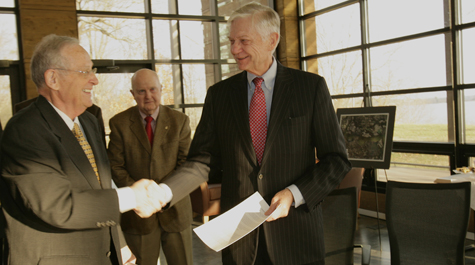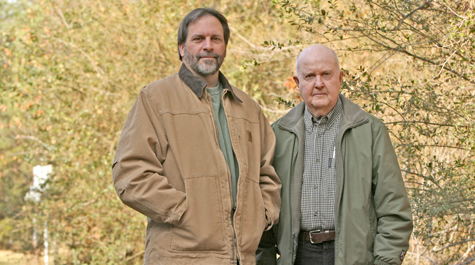Conservation collaboration begins with VCU
VCU President Eugene P. Trani and College of William & Mary President Taylor Reveley signed a memorandum of understanding on Jan. 26. The agreement states that William & Mary’s Center for Conservation Biology will continue to draw upon its extensive academic programs in biology, bio-science and computational modeling, while providing a close connection with the considerable expertise within the VCU Rice Center for Environmental Life Sciences, including in the ecological and environmental sciences, ecological genomics and conservation medicine.
“This is good for both universities, the people of Virginia and to the scientific community,” Trani said. “One of the priorities of my administration has been to work collaboratively with the College of William and Mary and this agreement brings together two very strong areas of expertise.”
“Research increasingly involves collaboration," Reveley said, "between individuals and between departments. Indeed, some of the newest and strongest collaborations will be between universities, such as the VCU-William & Mary Health Policy and Law Initiative and this exciting new partnership in conservation biology."
Launched in 2008, the VCU-William & Mary Health Policy and Law Initiative draws on faculty from the two institutions to conduct research, provide public service and offer joint degree programs that focus on solving topical problems in health policy, law and bioethics.
The mission of the Center for Conservation Biology centers around research aimed at ensuring the sustainability of bird populations. The CCB was founded at William & Mary in 1991 by a group that included its current director, Bryan Watts, as well as Mitchell Byrd, a pioneer in wildlife conservation issues. Byrd is Chancellor Professor Emeritus of Biology at William and Mary and remains active in field work after more than 50 years.
“We design and conduct research to answer questions critical to conservation progress,” Watts said. Currently, the center conducts around 40 research projects each year, ranging from the effects of habitat loss to recommendations on land use to tracking of populations of sensitive species in various ecosystems.
The CCB is best known for its work with bald eagles in the East, including its annual census flights of eagle nests along the Chesapeake and its tributaries. The center was named a 2007 National Recovery Champion by the U.S. Fish and Wildlife Service for its involvement with the recovery of the bald eagle in the eastern U.S.
The VCU Rice Center, VCU’s biological field station, is a 343-acre site in Charles City County overlooking the James River, midway between the two university’s campuses, with a primary mission of enhancing science, education and public outreach related to large river ecosystems and their riparian landscapes.
The new collaboration will be renamed the College of William & Mary/Virginia Commonwealth University Center for Conservation Biology at the VCU Rice Center. Faculty at the center will hold joint appointments at both institutions. Watts will continue as director.
The CCB’s eventual relocation to the Rice Center will place it adjacent to one of its frequent partner institutions, the Virginia Department of Game and Inland Fisheries. Watts said the new relationship with VCU will offer a number of opportunities for fruitful, collaborative research.
“We do a lot of work with eagles, ospreys, cormorants—water birds that depend on fish,” Watts said. “And VCU is very strong in fish research. There’s one natural area of collaboration that we want to take advantage of. There are many others we’ll investigate.”
The VCU Rice Center features a 4,900-square-foot, LEED-certified education building with lecture and laboratory rooms, a conference room and administrative offices as well as an outdoor classroom pavilion. It was created from an ecology-rich parcel of land that Inger Rice donated to VCU in 2000. It also has a research pier that serves as the front-door from the river. VCU and the Department of Game and Inland Fisheries dock their boats in the six-slip facility. An attached floating platform dock can accommodate visiting boats and the loading of research equipment.

















